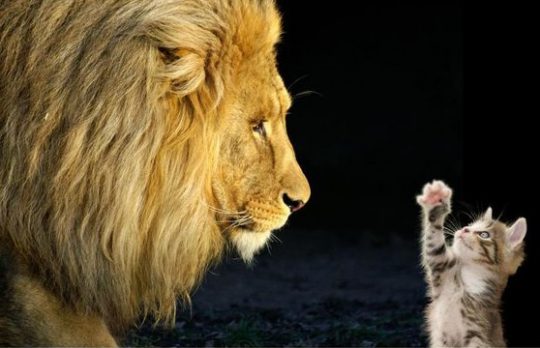Throughout the world, animals are perceived in a variety of ways through tradition, mythology and religious beliefs. An illustrated logo may infer strength, speed or quality of their work.
Cats
The feline family is relatively diverse from the cute little kitten to the immense roar of the Lion. It is an intelligent, agile and independent species associated with both positive and negative fortunes.

In Asia, the passionate ferocity and beauty of the Tiger is connected with royalty in countries such as Japan, China and Malaysia. As a contrast to Lions in European heraldry, the Chinese tiger is linked to the God of wealth Tsai Shen Yeh. Asian art normally depicts the feline as a steed on which the deity rides. Being one of twelve animals in the Chinese zodiac, their use in creating medicines was considered to revitalise and heal those who were ill. It is a symbol of passion, speed and strength whilst being a talisman to ward away evil spirits. In Hinduism, the Tiger is one of many sacred animals that carry the Goddess Maa Durga during the Navratri festival for nine nights. This is in accordance with the Hindu lunar calendar which, as a Western equivalence passes around the late September to early October.
The Lion is acknowledged as the most powerful of animals and this is commonly noted on Western Royal emblems, Eastern temples and worldwide monuments and prestigious buildings. The calm demeanour and disciplined self-control is admired by many in Asia whilst the power and overwhelming strength is equally favoured by the West. Other cats, known for their graceful speed and power feature prominently as national animals. For example, the lynx for Romania and the Leopard for Rwanda.
In Europe, a black cat is linked to superstition and negative energy whilst sailors believed their presence on board a ship was actually lucky. The colour black is often connected to mystery, death and misfortune so it is unsurprising that crossing paths with a feline of this colour is considered a bad omen. In medieval times, they hunted plague carrying rodents to great delight whilst being revered as a deity in Egyptian folklore as the
Guardian of the dead.
Brand logos featuring large cats such as the Puma for sporting products and the Jaguar for automobiles are a few examples of interpretive marketing for elegance and speed.
Birds
Throughout the world, they have been used as messengers, hunters and even food themselves. Dependant on the species, their generic meaning to many cultures has always been one of grace, beauty and transcendence.

In South America, the Incan empire perceived birds as travellers between earthly and spiritual realms whilst Etruscan and Roman religions used them in a practice known as Augury whereby the flight of birds determined the foretelling of events. The Parsee community in India and Iran observe them religiously as part of a sky burial ceremony. Similarly, in Japan, these avian creatures are also associated with death as guides into the afterlife, yet they are also seen in some cases as reincarnations of those who have passed. The traditional art of Origami reflects the importance of the revered Crane in Japanese culture. Wedding gifts of these paper birds are symbolic of their bearer’s intent to see a long and happy marriage.
According to Western medieval heraldry, the Eagle was considered through the sport of Falconry to be the King’s equivalent fowl. No other peer or commoner could own one. The ancient Greeks related them with Zeus, the King of the Gods whilst Norse legend associated Eagles with their Deity Odin since it displayed instinctive wisdom when hunting.
Appearing on many insignia to symbolise freedom, strength and courage, they are often carefully positioned to affirm deeper meaning. The Mexican flag displays an Eagle on an island rock overcoming a snake. Western perspective observes two animals in battle between good and evil, however the image holds a deeper spiritual connotation since it was based on the birth of New Mexico within the Aztec empire. This example demonstrates multiple interpretations of birds on national banners. Presidential flags are known to carry this animal to demonstrate power, action and intelligence.
Celtic mythology and Viking culture had both applied the Raven to themes of war and fighting, whether it was a Norse banner or the Irish deity Morrigan. Ravens are traditionally considered in Sweden to be the ghosts of the deceased whilst Aborigines and native Americans believed that they were originally white but became darker in their links with the dead. The Tower of London had a tale that if the Ravens flew away from the grounds, the Kingdom would fall. Great care and attention was made to ensure that this would never happen by clipping the wings to allow perching but little else.
Brand logos worldwide will predominantly use these to convey travel or messaging products. It is common to see these on airlines and postal services as they suggest a naturally safe way of getting to a location in good time.
Horses

Greek mythology placed the horse in a celestial position through the winged Pegasus whilst the Chinese equivalent, the Longma was a flying half dragon hybrid. In Hinduism, Lord Vishnu’s incarnate appearance as Hayagriva was defined by a human body with a horse’s head. Revered as the God of Knowledge, his presence in pure white garments marked a victory over darkness. In Roman Europe, Epona was the goddess of fertility and a protector of horses who was worshipped throughout the empire between the first and third centuries. As they became widely used for transporting people further across continents, their riders brought with them new languages, culture and technology which would evolve civilisations.
Symbolic of power and virtue, they became a reflection of wealth and nobility. Native Americans could tell the prosperity of a tribe by the horses they
owned since it would indicate the vast territory in which they governed. Renowned for their speed, vitality and beauty, they are often perceived as a powerful and free spirit used for transportation, agriculture or warfare. Their behaviour in groups, according to folklore would indicate bad weather and forewarn humans to be alert.
As mechanisation evolved, their roles have become more sports orientated and they still have a prominent part in society as the only animal to compete alongside humans in the Olympic games. Today business logos that use horses infer speed, sophistication and affluence. The world’s best cars and designer clothing brands for wealthy consumers display a prancing horse whilst the traditional view of a faithful pony is represented by one leading British bank.
Brand Logos and Animals
Many animals display different characteristics and displaying them on a company logo will tell others about how a product operates. Whether a new car has horsepower or the elegant pace of a cat can determine what car we purchase. In the same way, an airplane with a falcon will sell more seats than one with a chicken. In selecting which animals constitute a good business sign, colour will play an equal part in its success. By matching these two criteria together with some well researched forethought, the best cultural interpretation can be made to a target market.
